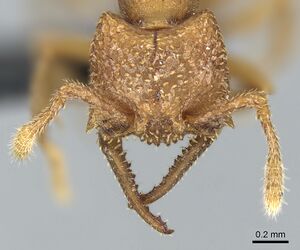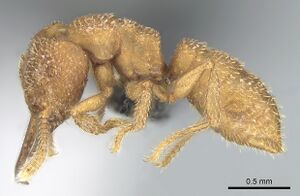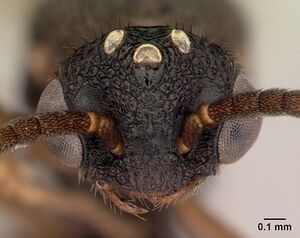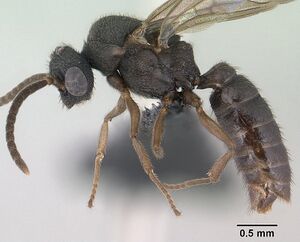Mystrium barrybressleri
| Mystrium barrybressleri | |
|---|---|

| |
| Scientific classification | |
| Kingdom: | Animalia |
| Phylum: | Arthropoda |
| Class: | Insecta |
| Order: | Hymenoptera |
| Family: | Formicidae |
| Subfamily: | Amblyoponinae |
| Tribe: | Amblyoponini |
| Genus: | Mystrium |
| Species group: | camillae |
| Species: | M. barrybressleri |
| Binomial name | |
| Mystrium barrybressleri Yoshimura & Fisher, 2014 | |
Mystrium barrybressleri has been found in rainforest and montane rainforest.
Identification
Yoshimura and Fisher (2014) - The workers of Mystrium barrybressleri can be distinguished from other Mystrium workers and queens in the Malagasy region by a combination of the following characters: mesosoma lacking wing-sclerites; first flagellomere (third segment of antenna) shorter than pedicel (second segment of antenna); and second maxillary palpomere shorter than third. The wider petiole in dorsal view separates M. barrybressleri workers from the other Mystrium workers in the Malagasy region. A combination of smaller body size, small lateral ocelli distant from the eye, rounded posterior margin of head with protruding lateral ocelli in full-face view, cu-a on the forewing located at junction of Media (M) and Cubitus (Cu), wide and short petiole in dorsal view, and fine punctation on abdominal tergite III separates M. barrybressleri males from other known Mystrium males in the Malagasy region.
The workers of Mystrium barrybressleri are most similar to those of Mystrium camillae but can be distinguished by the shape of the propodeum. In workers, the lateral portion of the propodeum is steeply and strongly convex in M. camillae, while the convexity is gentle and weak in M. barrybressleri. Also, in M. barrybressleri, minor workers have setae much narrower and simpler than those of major workers, while in M. camillae minor and major workers have similar setae. There are additional differences with M. camillae (sensu stricto, as defined by the syntype series from Myanmar). The pair of spatulate setae on the anteromedial portion of clypeus is distinctly longer in M. barrybressleri than those in the syntype series of M. camillae. The queen of M. barrybressleri can be distinguished by the presence of simple setae on the pronotum, while in M. camillae sensu stricto, the setae are clavate.
Keys including this Species
Distribution
Latitudinal Distribution Pattern
Latitudinal Range: -12.26278° to -24.9815°.
| North Temperate |
North Subtropical |
Tropical | South Subtropical |
South Temperate |
- Source: AntMaps
Distribution based on Regional Taxon Lists
Malagasy Region: Madagascar (type locality).
Distribution based on AntMaps
Distribution based on AntWeb specimens
Check data from AntWeb
Countries Occupied
| Number of countries occupied by this species based on AntWiki Regional Taxon Lists. In general, fewer countries occupied indicates a narrower range, while more countries indicates a more widespread species. |

|
Estimated Abundance
| Relative abundance based on number of AntMaps records per species (this species within the purple bar). Fewer records (to the left) indicates a less abundant/encountered species while more records (to the right) indicates more abundant/encountered species. |

|
Biology
|
Castes
Worker
Images from AntWeb
   
| |
| Paratype of Mystrium barrybressleri. Worker. Specimen code casent0129839. Photographer Estella Ortega, uploaded by California Academy of Sciences. | Owned by NHMUK, London, UK. |
   
| |
| Paratype of Mystrium barrybressleri. Worker. Specimen code casent0129840. Photographer Estella Ortega, uploaded by California Academy of Sciences. | Owned by MHNG, Geneva, Switzerland. |
Queen
Images from AntWeb
   
| |
| Queen (alate/dealate). Specimen code casent0145109. Photographer Dimby Raharinjanahary, uploaded by California Academy of Sciences. | Owned by CAS, San Francisco, CA, USA. |
Male
Images from AntWeb
      
| |
| Male (alate). Specimen code casent0062047. Photographer Estella Ortega, uploaded by California Academy of Sciences. | Owned by CAS, San Francisco, CA, USA. |
     
| |
| Male (alate). Specimen code casent0112237. Photographer Erin Prado, uploaded by California Academy of Sciences. | Owned by CAS, San Francisco, CA, USA. |
     
| |
| Male (alate). Specimen code casent0135866. Photographer Dimby Raharinjanahary, uploaded by California Academy of Sciences. | Owned by CAS, San Francisco, CA, USA. |
Nomenclature
The following information is derived from Barry Bolton's Online Catalogue of the Ants of the World.
- barrybressleri. Mystrium barrybressleri Yoshimura & Fisher, 2014: 34, figs. 8B, 10A,C, 13A,C, 14A, 31A,C, 33A-C, 34A-C, 35A,B, 36A,C,E, 37A, 38A, 39A, 40A, 41A, 42A (w.q.m.) MADAGASCAR.
- Type-material: holotype worker, 2 paratype workers.
- Type-locality: holotype Madagascar: Toliara, Forêt Ivohibe, 55.0 km. N Tolagnaro (-24.569°, 47.204°), 200 m., 2-4.xii.2006, BLF15450, CASENT0129838 (B.L. Fisher, et al.); paratypes with same data but CASENT0129839, CASENT0129840.
- Type-depositories: CASC (holotype); BMNH, MHNG (paratypes).
- Distribution: Madagascar.
Unless otherwise noted the text for the remainder of this section is reported from the publication that includes the original description.
Description
Worker
Measurements: holotype. HL 1.26, HW 1.14, SL 0.69, ML 1.08, HD 0.72, WL 1.18, PnW 0.63, PpW 0.50, PtW 0.56, PtL 0.28, CI 90.5, SI 60.7, MI 94.5, PpI 79.7, PtI 198.2. HL 0.79–1.52, HW 0.71–1.49, SL 0.46–0.89, ML 0.67–1.41, HD 0.47–0.91, WL 0.85–1.51, PnW 0.46–0.78, PpW 0.36–0.60, PtW 0.39–0.68, PtL 0.19–0.30, CI 89.7–100.4, SI 56.0–69.9, MI 86.4–97.5, PpI 77.1–87.5, PtI 199.0–227.8 (10 specimens measured).
Posterolateral corner of head strongly to moderately expanding posteriorly. Posterior face of vertex forming slightly blunt angle with dorsal face on median line of head, so that declivity of vertex on lateral part slightly steeper than on median part. Ventral half of vertex sculptured. Eye small, only with several ommatidia. Anterior margin of clypeus convex with long, conical setae, of which median pair larger than adjacent pair. Genal tooth of head moderately developed, reaching about half of lateral lobe of clypeus. Masticatory margin of mandible slightly visible in full-face view, and dorsal surface on distal portion of mandible slightly wider than that on mandibular shaft. Second maxillary palpomere shorter than third. First flagellomere (third antennal segment) about 0.5× length of pedicel (second antennal segment). Central part of pronotal dorsum strongly to weakly, and regularly reticulate. Lateral surface of pronotum strongly and regularly reticulate on its posterior portion. Mesonotum distinct in dorsal view, its length slightly shorter than that of propodeum. Metanotal groove shallowly impressed and mesonotum higher than pronotum in lateral view. No carina present on dorsal edge of metapleural gland bulla. Petiole extremely wide in dorsal view (PtI>195).
Body color yellowish brown to reddish brown.
Queen
Measurements: HL 1.43, HW 1.52, SL 0.88, ML 1.10, HD 0.99, WL 2.05, MnW 1.23, PtW 1.12, PtL 0.46, CI 106.8, SI 58.0, MI 72.1, MnI 80.8, PtI 243.1 (one specimen measured).
Wings present and well developed. Wing sclerites fully developed even if wings have been removed. Posterolateral corner of head moderately expanding posteriorly; expansion weaker than that of workers. Posterior surface of vertex forming slightly blunt angle with its dorsal surface on median line of head, so that declivity of vertex on lateral part slightly steeper than on median part. Ventral half of vertex weakly sculptured, almost smooth. Eye well developed. Both anterior and lateral ocelli clearly present, median portion of lateral ocelli and posterior portion of anterior ocellus edged by blackish pigment. Anterior margin of clypeus convex with long conical setae, of which median pair larger than adjacent pair. Genal tooth of head moderately developed, reaching about half of lateral lobe of clypeus. Masticatory margin of mandible visible in full-face view, and width of dorsal surface on distal portion slightly wider than that on mandibular shaft. Spoon-shaped seta present on basal side of each basal denticle on masticatory margin of mandible. First flagellar segment on antenna short, about 0.5× length of pedicel. Setae on pronotum almost simple, narrowing distally with strongly sharpened apex. Propodeal declivity in lateral view straight, making right angle with its dorsal margin. Petiole wide and short in dorsal view, 0.25× length of abdominal segment III.
Body color yellow to yellowish brown.
Male
Measurements: HL 0.72–0.86, HW 0.91–1.17, SL 0.16– 0.22, EL 0.39–0.45, WL 1.28–1.78, MnW 0.81–1.22, CI 126.8–137.5, SI 16.7– 18.9, EI 52.5–55.7, MnI 88.8–108.2 (5 specimens measured).
Eye moderately large, occupying 0.6× head length. Ocelli protruding from dorsal margin of head in full-face view. Dorsal margin of head in full-face view rounded. Both anterior and lateral ocelli small. Lateral ocellus small and distant from eye: distance between these more than 2× maximum diameter of lateral ocellus. Posterior half of vertex clearly differentiated from its dorsal half, its dorsal face distinctly shorter than its posterior face. Palpal formula 4,3. First segment of maxillary palp flattened and distinctly wider than second segment. Second maxillary palpomere shorter than third. Notauli weakly impressed on mesoscutum, but often unclear or absent. Petiole in dorsal view thin, its length 0.5× that of abdominal tergite III. Petiolar dorsum covered with fine punctures. Abdominal tergum VIII without deep punctures, almost smooth.
Distal portion of abdominal sternum IX smooth and not punctured. Basal ring quite short, not extending basally. Telomere slightly extending distally more than digitus. Basoventral expansion of aedeagus well developed basoventrally, distinctly longer than dorsal extension. Ventral margin of aedeagus gently curved ventrally in lateral view. Aedeagus moderately narrowing distally on its distal half and its distal portion narrowly rounded.
On forewing, cu-a usually located at junction of Media (M) and Cubitus (Cu), sometimes slightly basal from junction.
Body color reddish brown to blackish brown.
Type Material
Holotype. Worker: CASENT0129838, BLF15450, MADAGASCAR, Toliara, Forêt Ivohibe 55.0 km N Tolagnaro (-24.569°, 47.204°), 200 m alt., 2–4.xii.2006, B.L.Fisher et al. leg. California Academy of Sciences. Paratypes. 2 workers: CASENT0129839 The Natural History Museum, CASENT0129840 Musee d'Histoire Naturelle Genève, same data as holotype.
Etymology
The specific epithet is the patronym of Dr. Barry Lee Bressler, retired physicist, former adjunct professor of physics at Virginia Polytechnic Institute and State University, and amateur naturalist, in recognition of his interest in myrmecology and his support for research on ants.
References
References based on Global Ant Biodiversity Informatics
- Blaimer B. B., S. G. Brady, T. R. Schultz, and B. L. Fisher. 2015. Fucntional and phylogenetic approaches reveal the evolution of diversity in a hyper diverse biota. Ecography 38: 001-012.
- Yoshimura M., and B. L. Fisher. 2014. A revision of the ant genus Mystrium in the Malagasy region with description of six new species and remarks on Amblyopone and Stigmatomma (Hymenoptera, Formicidae, Amblyoponinae). ZooKeys 394: 1-99.


